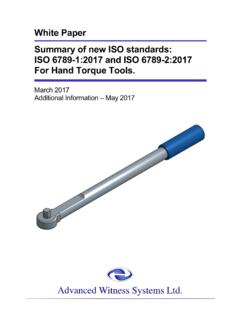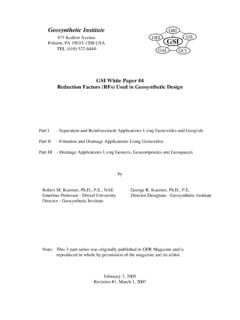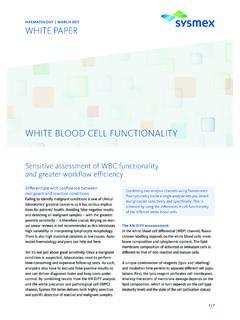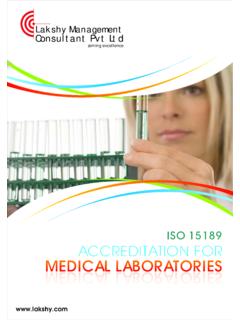Transcription of BUYERS GUIDE> process control & inspection Effect …
1 Effect of coatings on adhesion of labels to glass containers Adequate levels of hot end and cold end coatings are necessary to assure that non-refillable glass containers will move properly through high speed filling lines and to assure that the surface of these containers are adequately protected from becoming damaged during sliding contact. The current use of thin layers of tin oxide, applied immediately after forming while the glass is still hot and polyethylene, applied after the annealing process , is fully capable of achieving these objectives. However, if these coatings are improperly applied, performance problems of the coated containers can be observed. One such problem is the lack of adhesion of paper labels when using common glues.
2 Gary Smay summarises the results of studies to determine the Effect of tin oxide and polyethylene coatings on label adhesion when using casein-type (NR) glass containers have been successfully used for over 50 years in the beverage, food, wine and spirit industries. These containers have less weight and corresponding thinner glass compared to their refillable counterparts, which requires that the outside surfaces of these containers are protected with hot end and cold end coatings. These coatings create both lubricious surfaces that enable the containers to move smoothly through filling lines and scratch resistance that maintains glass strengths at relatively high values(1).
3 When applied appropriately, these coatings do not cause any problems for either the manufacturer or the filler of glass containers. However, on rare occasions, some problems can arise. One of these potential problems concerns the adhesion of BUYERS GUIDE > process control & inspectionlabels to the glass surface. This study explores the Effect that both hot end and cold end coatings have on proper label adhesion when using a casein-type adhesive that is typical of those used in the industry. BACKGROUND The methodology of depositing both hot end and cold end coatings onto the surface of NR glass containers has been well documented(2). Currently, mono-butyl tin tri-chloride (MBTC) is the most common precursor material that is used to deposit tin oxide hot end coatings.
4 When examined under high magnifications in an Atomic Force Microscope (AFM), this coating consists of individual globules of tin oxide that are randomly distributed across the glass surface, as shown in figure 1 (3). As measured thicknesses increase, both the size and number of these globules increase until a value of about 40 CTU is achieved, which coincides with complete coverage of the glass surface. Once complete coverage is achieved, additional hot end coating simply adds to the depth of the physical thickness. In conjunction with the nature of the tin oxide coating, it has been observed that both the physical and chemical properties of the coating also change up to about 40 CTU, after which these characteristics remain constant with further increases in coating thicknesses (1,4,5).
5 A slightly oxidised, low density form of polyethylene is the most common type of cold end coating in use today for NR glass containers. This coating is applied as a highly atomised spray of a dilute aqueous suspension of solid polyethylene particles. The coating is deposited as numerous dried, circular droplets on the glass surface, as shown in figure 2 (6). Normally, the dried droplets do not overlap and consequently, the polyethylene cold end coating does not completely cover the glass surface. However, when excessive amounts of polyethylene are deposited, complete surface coverage is observed and the glass is essentially encapsulated by the polymer coating. When these hot end and cold end coatings are properly applied, they provide excellent surface lubricity and scratch protection under both dry and wet sliding conditions, with no associated performance problems relative to the adhesion of paper labels when using common glues.
6 However, if certain glues are used that are incompatible with the coatings on the glass surfaces, then some interference with proper label adhesion can be anticipated. GLASS WORLDWIDE > issue sixty nine 201768 Subscribe online at 1: Physical characteristics of tin oxide L Smay, Senior Scientist at American Glass GUIDE > process control & inspectionFor example, dextrin type glues, initially intended for non-coated refillable bottles, are not tolerant of the chemistry and surface energy of glass surfaces that are well coated with both tin oxide and polyethylene. Therefore, this glue will not perform well when used to label well coated NR glass containers. Conversely, synthetic glues have been developed for polymer surfaces and as a consequence, are very tolerant of even well coated glass surfaces and will result in complete label adhesion for NR glass containers.
7 However, purely synthetic glues are relatively expensive and difficult to use in commercial practice and are not employed on a routine basis for NR glass containers. Therefore, fillers tend to utilise glues such as casein or blends of glues that allow easy use on well coated bottles at a reasonable cost. In addition, it has been observed in previous, unreported tests that the deposition of excessive amounts of polyethylene results in complete coverage of the glass surface. This changes the chemical nature of the container surface from glass to essentially plastic. Other than synthetic glues, most other types of adhesives intended for use with glass containers will not function well when applied onto a plastic surface.
8 EXPERIMENTAL PROCEDURES mall capacity flint glass food jars were used as the substrates in the current study. These were commercially manufactured and coated with tin oxide from MBTC at three hot end thickness ranges. These ranges were: 0-10 CTU, 25-40 CTU and greater than 50 CTU (see(7 and 8) for a definition of a CTU and how it is measured. The lowest range was used in this study as a comparative baseline of essentially uncoated surfaces. The middle range was typical of hot end coating thicknesses that are applied onto NR glass containers in normal commercial practice. The highest thickness range was chosen as the values at which the hot end coating is essentially a thin continuous film, which exhibits consistent chemical and performance properties (1,4,5).)
9 Polyethylene coatings were applied to the sample containers in the laboratory under carefully controlled conditions on rotating bottles to assure uniform vertical and circumferential distributions. The deposition parameters were adjusted to deposit coatings that replicated normal commercial amounts, as well as amounts that would be considered excessive and likely to interfere with proper label adhesion. A third set of samples was also created that were not coated with polyethylene. These were used as the second set of baseline samples in this study. The polyethylene material that was used in these studies consisted of Duracote that was diluted to the normal commercial concentration of 100 parts of deionised water to one part of the Duracote concentrate.
10 This coating was applied through an atomising spray gun onto the sample containers at a glass temperature of 120 C. The extent to which the glass surface was covered by the polyethylene cold end coating was determined by a contact angle technique. In this technique, a 10 micro-litre droplet of deionised water was placed onto the glass surface while the test bottle was held in a horizontal position on the stage of an optical comparator. The angle that the periphery of the droplet made with the glass surface was then measured, as shown in figure 3. These measurements were made on each of the test bottles at six evenly spaced circumferential locations and at two vertical heights corresponding to the location where the labels were to be subsequently applied.







